Topic outline
-
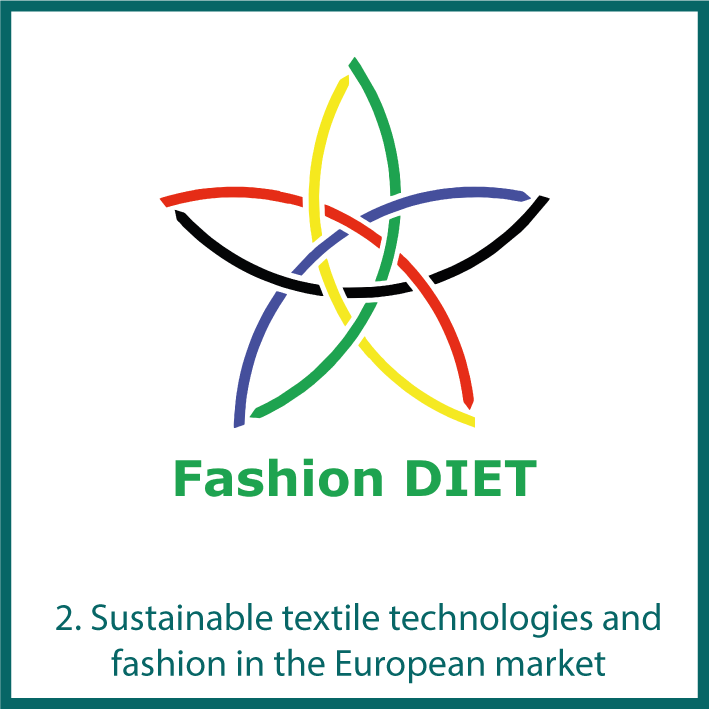
The ESD Module Part 2 "Sustainable Textile Technologies and Fashion in the European Market" consists of the following 14 lectures:
Fashion Design in the Contextof Sustainable Development of the Fashion and Textile Industry (Part 1)
Pattern Making in the Contextof Sustainability: Good Practices
Best Practices of Sustainable Product Development through 3D-Design and Visualization
Clothing Technology and Production Methods in the Context of Sustainability
Social, Health and Environmental Impact in Textile and Apparel Manufacturing Processes
Selected Projects of Students at Partner Universities (Part 1)
Chances and Risks of a Sustainable Textile and Clothing Production in the European Market
All learning materials provided are for non-commercial use only and are licensed under "CC-BY-NC" from Creative Commons.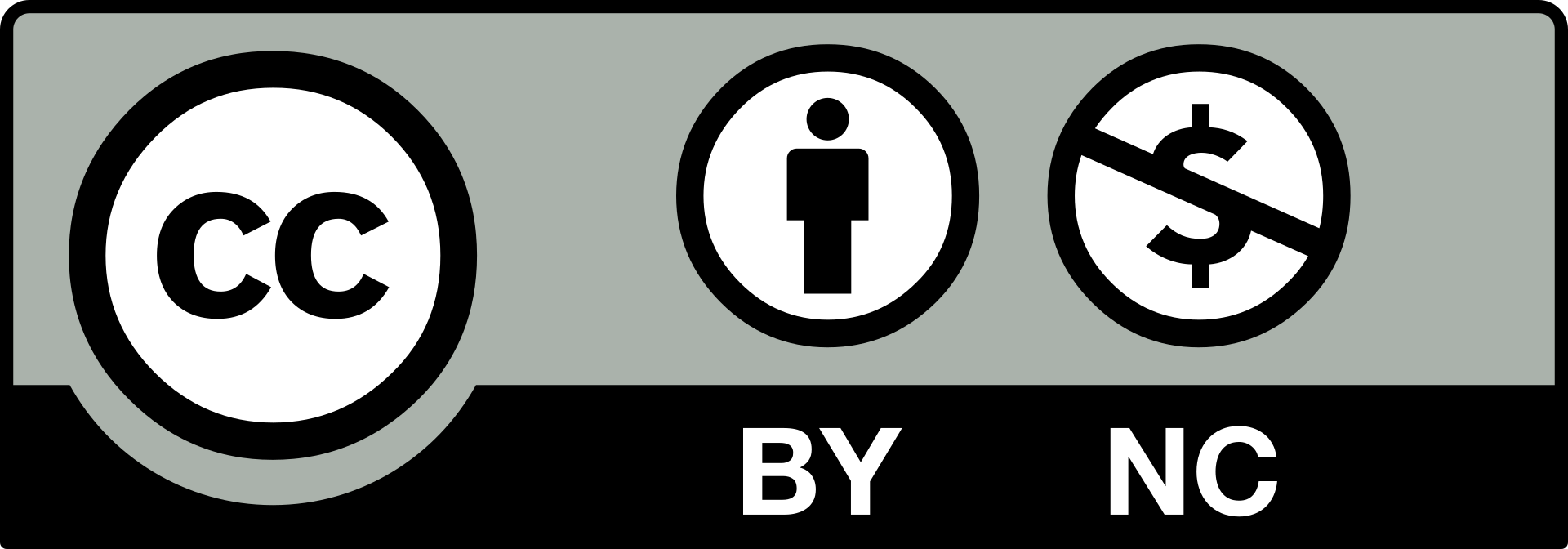
-
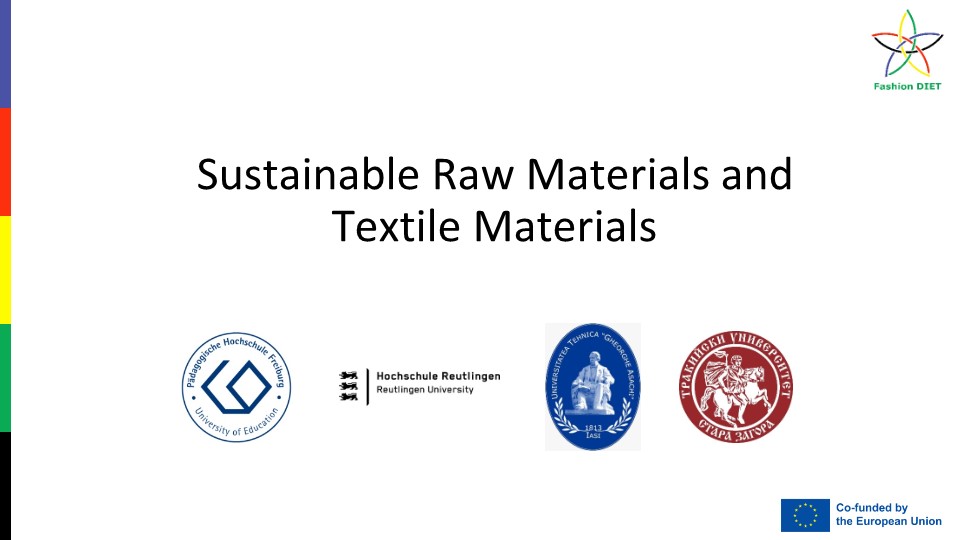
The global fibre market was about 113 million tonnes in 2021 and is expected to increase to about 149 million tonnes by 2030. Natural fibre production goes hand in hand with a high demand for land and water and, in conventional production, also with the use of pesticides and artificial fertilisers. Man-made fibre production, on the other hand, has a high consumption of petroleum and energy. Cotton is still the most important natural fibre. The central environmental burdens of cotton cultivation are water consumption through artificial irrigation and the use of pesticides and artificial fertilisers. Organic cotton cultivation is the most popular form among the cultivation alternatives, but its global production continues to lag all other alternatives in terms of volume, with less than 1.5 per cent market share. Genetically modified cotton has become much more important. Its cultivated areas now account for over 79 per cent worldwide. Other more sustainable cottons are focused on better pesticide and water management and/or fair pay for people working in the cotton industry. Sheep's wool accounts for over 1 million tonnes of the fibre produced worldwide, making it the most important natural animal fibre. Angora, alpaca, camel, cashmere, llama and mohair wool have a very small share compared to sheep wool. There are some unsustainable practices in conventional animal husbandry, which is why animal welfare standards and certifications have been introduced.
Pulp production for man-made cellulosic fibres should be based on sustainable forestry, and production waste from the cellulose spinning mill and waste from cotton production can also be used. The amount of chemicals used in viscose and modal fibre production is very high. An alternative is the direct solvent process, in which the cellulose is spun into lyocell fibres in the organic solvent amine oxide N-methylmorpholine-N-oxide (NMMO). The manufacturing process, which has the highest solvent reusability of all cellulose fibres, is considered to be significantly more environmentally friendly compared to the processes of other regenerated cellulosic fibres. Man-made fibres from synthetic polymers, which are mainly produced from the petroleum derivative naphtha, cover most of the global fibre production. The problem lies in the finite nature of the resources. Another problematic factor is the energy required and the chemicals used as auxiliaries in the production of synthetic man-made fibres. Synthetic fibres contribute to environmental pollution with microplastics during production, wearing and washing.
When it comes to the search for a solution that contributes to a circular economy and to covering the world's demand for fibres, the recycling of textiles and old clothes comes to mind. Especially so, when thinking about the ever-growing volume of old clothes. On the way to closed material cycles, however, fibre mixtures between fibres based on natural and synthetic polymers in particular make recycling difficult. Additionally, the fibres lose considerable quality during recycling, which is why they must be disposed of again in the end. As long as this problem has not been solved, the principle of grade purity applies to high-quality raw material recycling. So far, the recycling of PET bottles into polyester fibres has become established. The plastic bottles can be processed either chemically via depolymerisation or physically. The recycling of polyester textiles requires the collection of e.g., ocean plastic, washing, decolourising and melting, which entails a high input of energy and chemicals.
Bio-based plastics made from sugar, starch, vegetable oils or even chitin represent an alternative source of raw materials for textiles. The term plastics is used because these materials are rarely present as fibrous materials. The term bioplastics is not a defined term, as it is sometimes used for biodegradable plastics, but also for plastics made from renewable raw materials that are not biodegradable. A disadvantage of the plant origin of bioplastics is the fact that the cultivation of the required raw materials competes with the cultivation of food and animal feed. In the search for raw materials for bio-based polymer fibres and bioplastics, the recycling of food waste is therefore increasingly being considered. Some of this discarded food, or even its components, which are not intended for consumption, can be processed as organic raw materials into new textile fibres and leather substitute products. Due to the growing world population, which is moving more and more into the middle class, and the thus increasing world demand for fibre, the high resource throughput is the most pressing problem. Therefore, the real problem lies in consumption, based on short fashion cycles and a textile economy that has not been able to recycle so far. The sustainability of textile products is based on a durable product design with a recyclable raw material input.
Anne-Marie Grundmeier
Content:
-
Please find below the PDF document of the lecture “Sustainable Raw Materials and Textile Materials”.
The document contains notes by the author.
-
Please find below the Powerpoint presentation of the lecture “Sustainable Raw Materials and Textile Materials”.
The presentation contains notes by the author.
-
Here you can download all documents of the lecture in a bundle:
-
Please give us your Feedback on the Lecture “Sustainable Raw Materials and Textile Materials”.
-
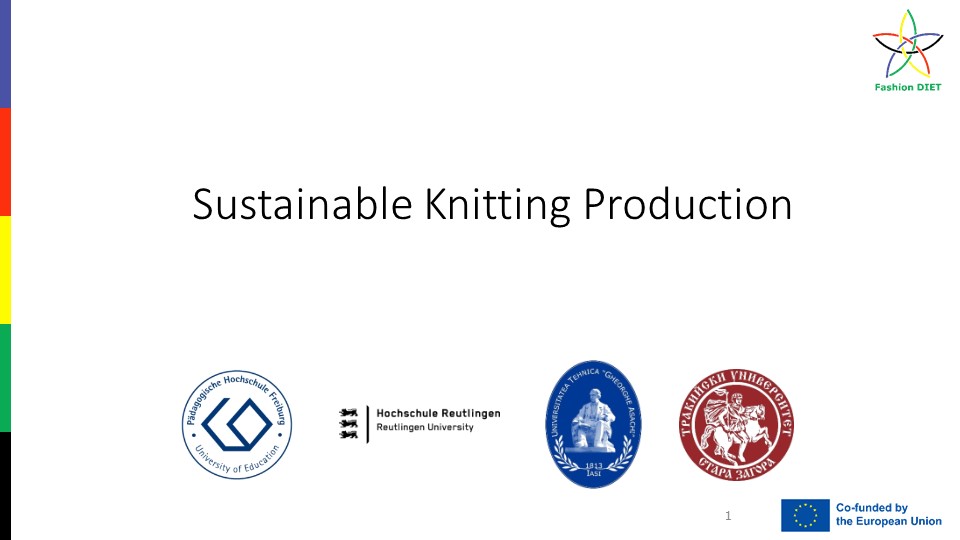
One of the oldest textile techniques, knitting has long been considered a complex and versatile technology for producing garment and non-garment items made in one piece or in components that are joined together by sewing and/or linking. It includes warp/weft knitting, narrow/wide and flat/circular machines.
As a modern technology, knitting should be adapted and developed to the circular economy and Industry 4.0 in terms of sustainability to be economically viable in the near future.
Given the increasing demand for knitwear, this industry should play an important role in saving energy, reducing waste and minimizing emissions to meet environmental standards at a general level.
To achieve sustainability, all players in the knitwear industry should contribute and find reliable solutions.
Manufacturers have addressed key issues for sustainable knitwear production, such as:
- use of sustainable raw materials for knitwear production;
- reuse, recycling and upcycling of raw materials;
- reduction or even elimination of knitwear waste;
- implement energy-efficient technologies and minimization/avoidance of emissions;
- use of environmentally friendly chemicals.
Manufacturers and consumers have also rethought processes, production and consumption. The focus is on knitting machines with environmentally friendly manufacturing processes that have less impact on people and the environment.
Wholesalers and retailers should promote the business of sustainably produced knitwear. Consumers are very aware of sustainable products, but the purchase decision is still determined by the price and not by the environmental impact of the product. The procurement department of knitting companies must carefully select raw materials for knitting. The basis for selecting raw materials should be organically grown or produced in an environmentally friendly or recycled process. Sustainability testing should be mandatory for all knitted consumer goods to boost business.
This module outlines the general context of knitting technologies and focuses on sustainable developments in knitting, particularly in electronic flat knitting, as reflected in the authors' experiences.
The reader will find information on some key points of the sustainable development of knitwear production, starting with the general trends related to sustainable textile production, the main categories of knitwear products and processes, sustainable solutions for the knitwear industry, and ending with the presentation of digital solutions that have recently become available in the knitwear industry.
Mirela BLAGA & Marlen WAGNER
Content:
-
Please find below the PDF document of the lecture “Sustainable Knitting Production”.
The presentation contains notes by the author.
-
Please find below the Powerpoint presentation of the lecture “Sustainable Knitting Production”.
The presentation contains notes by the author.
-
Here you can download all documents of the lecture in a bundle:
-
Please give us your Feedback on the Lecture “Sustainable Knitting Production”.
-
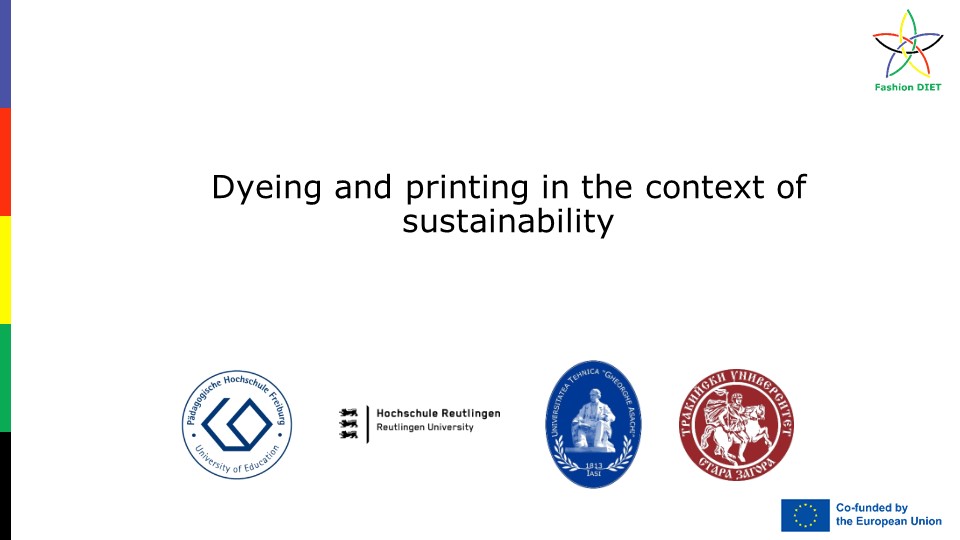
The textile industry, which has an extremely long and rich history, has always had a significant impact on the world economy and the evolution of human society itself. The last 100 years have been marked by significant transformations: the discovery of synthetic dyes, the development of chemical fibers, and the emergence of new areas of textile use.
We are currently witnessing a growing concern about the increasingly complex issues of environmental protection. Concerns are justified by the worsening of pollution, often with a tendency to globalization (visible changes in the climate regime, ozone depletion, unprecedented deforestation, desertification and arid phenomena, severe soil erosion and land instability, reduced natural resources, increasing pollution and anthropization of important ecosystems), with special economic and social implications.
In this context, the textile industry is experiencing a significant process of greening and streamlining specific technologies. This process, present in all stages of textile processing, has a special significance in the case of chemical textile finishing, responsible for the most significant environmental pollution of all the stages involved in the production of a textile product.
In the field of textile chemical processing, the problems are numerous, they being associated with the vast majority of specific processes, but among them of special attention are those related to the presence of dyes in wastewater from dyeing, and in connection with it (but not necessarily), the possibilities of wastewater recirculation. Discoloration solves one of the most difficult problems associated with textile wastewater (even if not the most serious), and often lays the groundwork for ensuring a process of recirculation of discolored water, with many benefits in terms of obtaining savings (water, reagents, energy, etc.).
Synthetic dyes are an element present in the vast majority of sectors of daily life, contributing significantly to its quality. The variety of colors of the products we use has become indispensable for modern man and that is why synthetic dyes are essential to meet the ever-increasing requirements of variety of shades, resistance of paints, and brightness of colors. However, because the large number and diversity of dyes demanded by the market, there has been a growing need to assess the impact that these dyes have on the environment and especially on water pollution. This is because, due to the not always very high degree of fixation, relatively high amounts of dyes end up in textile wastewater and, hence, in case of improper treatment, in watercourses.
The problems caused by dyes are to a small extent due to eco-toxicological considerations. However, a number of problems have been reported in this direction, usually solved by giving up the respective dyes.
Ecological design has gained significant significance over the last ten years, with increasing awareness of environmental issues in industry. While the primary focus has been on reducing pollution and the amount of waste produced, in recent years the focus has shifted from end-of-pipe approaches to overhauling technology as a whole to achieve the goals of reduced pollution and minimum quantities of waste. This new approach started from the finding that the impact of a technology on the environment is largely determined by the choice of materials used and the way in which the products made are used and then made available (by reintegration into the environment).
The environmental protection component of sustainable development in textiles is determined by both economic and environmental objectives, such as:
- the possibility to reduce production costs;
- high cost of water and costs and regulations related to waste disposal;
- energy costs;
- the need to reduce greenhouse gas emissions;
- consumer demand for organic textiles;
- environmental requirements in the international market.
One approach to environmental issues associated with the dyeing and printing processes is to optimize existing technologies. Process efficiency is fundamentally linked to environmentally friendly technologies. Doing "more with less" is the first step to sustainability. The production of quality goods using less energy, raw materials and auxiliaries, with the generation of little and non-toxic waste naturally leads to an increase in companies' profits, while also being beneficial for the environment.
A second way is to develop completely new dyeing and printing technologies, which ensure low water consumption, reduce the consumption of chemical auxiliaries, achieve a high degree of dye fixation and, consequently, protect the environment.
Even though important steps have been taken to ensure the sustainability of textile dyeing and printing processes, there are still many aspects to be improved in the years to come.Prof. Dr. Andrei Bertea
Content
-
Please find below the PDF document of the lecture “Dyeing and Printing in the Context of Sustainability”.
The document contains notes by the author.
-
Please find below the Powerpoint presentation of the lecture “Dyeing and Printing in the Context of Sustainability”.
The presentation contains notes by the author.
-
Here you can download all documents of the lecture in a bundle:
-
Please give us your Feedback on the Lecture “Dyeing and Printing in the Context of Sustainability”.
-
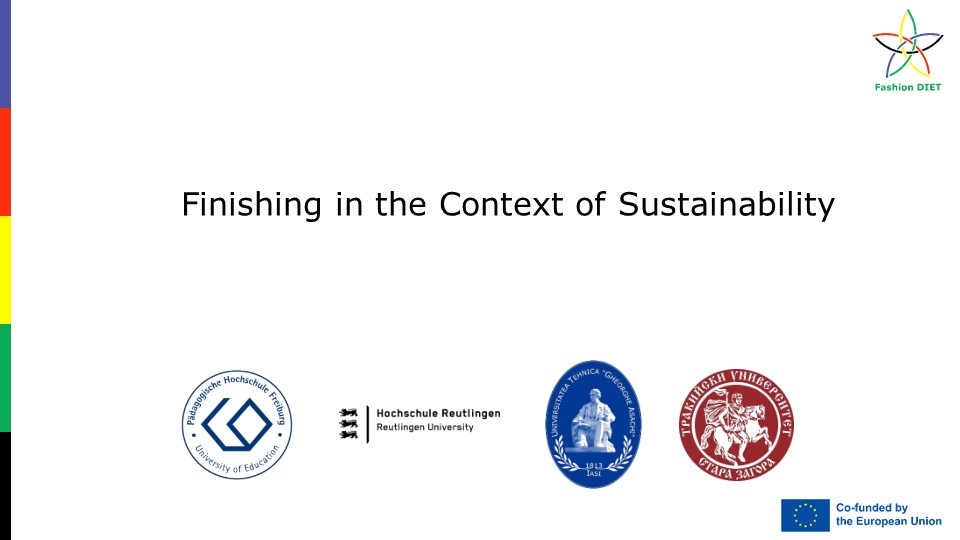
Textile finishing is a way to add new functionality to the fabric so that it becomes suitable for uses that are not normally accessible. Finishing can improve the resistance to burning, to attack of microorganisms, the action of UV radiation, the ability to recover from wrinkling, and much more. The last years mark a significant increase in the demand for functional textiles, specially developed to achieve a certain final goal, such as self-cleaning capacity, super hydrophobicity, antimicrobial activity, etc. Most of these processes require water, energy and chemicals, and some of the chemicals used are not environmentally friendly. In recent years, research has been intensified for the development of sustainable textile finishing technologies, characterized by low environmental impact, minimal energy consumption and safety for users, using biopolymers, biomaterials, water-free technologies.
Increasing the sustainability of textile finishing processes takes place on two levels: the substitution of environmentally friendly products, and the development of new environmentally friendly technologies.
Environmentally friendly products have replaced many chemicals, which have proven to be dangerous to the environment. Thus, halogenated flame retardants that have been commonly used have persistence in the environment, bioaccumulation and potential toxic effects on human health, and have therefore been replaced by halogen-free flame-retardants based on phosphorus-nitrogen (P – N), combined with other synergistic agents to prepare thermoplastic esters with good flame retardant properties. Formaldehyde anti-crease products responsible for formaldehyde releases have been replaced with products that contain small amounts of formaldehyde or do not contain it at all, such as DMDHEU (dimethylol dihydroxy ethylene urea) or DMeDHEU (N, N'-Dimethyl- 4,5-dihydroxyethylene urea).
New techniques and practices related to textile finishing have been developed to eliminate the harmful effects of chemicals that either are used in finishing processes or are released as a by-product. New finishing technologies aim to combine operations to achieve a variety of effects, such as anti-wrinkle, UV protection and antibacterial properties in a single step, using organic and inorganic chemicals that have a minimal impact on the environment.
Advanced, environmentally friendly textile finishing techniques include functionalization using nano-coatings, surface modification using hydrolysable silanes, microencapsulation, and increasing fiber strength using nano-coatings. Sol-gel coatings and layer-by-layer assemblies, depending on the composition of the sol-gel recipes and the type of layers deposited, allow for multifunctional treatments (e.g. flame retardancy, hydrophobicity, ability to conduct electricity).
Cold plasma treatments, which do not require the use of water, can be used in a wide range of situations, such as to activate the surface of the textile material or for coating and deposition to provide new functionality, water and oil resistance, fireproofing, protection UV or antistatic properties.
The chemical finishing is expected to accentuate the tendency to use more sophisticated chemical finishes, which are more environmentally friendly and are specially formulated for ease of application on automatic machines and equipment.
Prof. Dr. Andrei Bertea
Content:
-
Please find below the PDF document of the lecture “Finishing in the Context of Sustainability”.
The document contains notes by the author.
-
Please find below the Powerpoint presentation of the lecture “Finishing in the Context of Sustainability”.
The presentation contains notes by the author.
-
Here you can download all documents of the lecture in a bundle:
-
Please give us your Feedback on the Lecture “Finishing in the Context of Sustainability”.
-
Topic 5: Fashion Design in the Context of Sustainable Development of the Fashion and Textile Industry (Part 1)
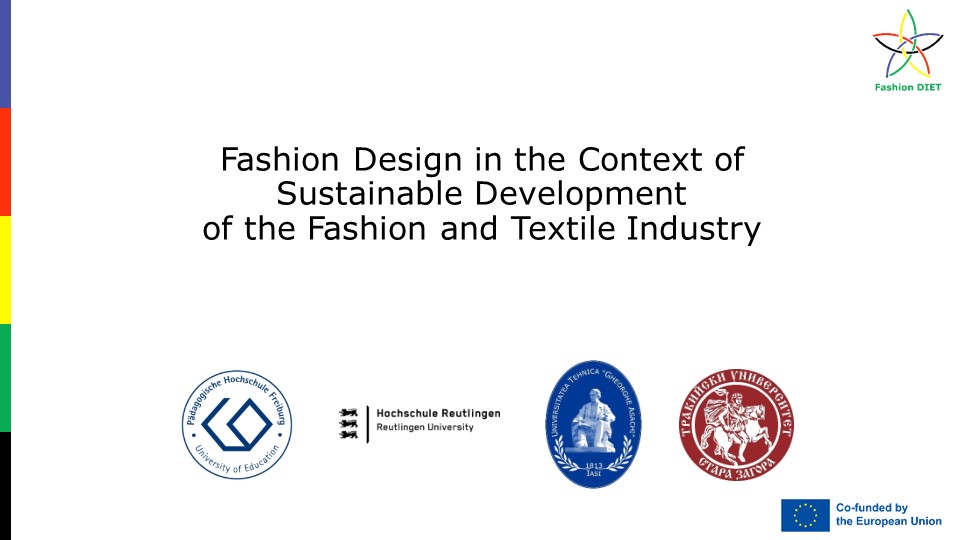
The wide-scale negative environmental and social impacts of the fashion industry are well known. In order to reduce these impacts, sustainable strategies and practices are more and more developed and implemented. In the 2020 circular economy action plan, the European Commission announced the adoption of the EU Textile Strategy in 2021. In the European Parliament LEGISLATIVE TRAIN 11.2021 - 1 A EUROPEAN GREEN DEAL is stated: “The textile industry has also been identified as a priority sector for the EU’s move towards sustainability in the European Green Deal and the New Industrial Strategy for Europe, due to its high use of resources and high impact on the environment.”
Sustainability is a very complex phenomenon and approach, for which there is no single or general definition. According to Gurova and Morozova (2016, p.2), the term ‘‘sustainable fashion’’ is used as an umbrella for many approaches and practices such as: focuse on taking and returning resources, sourcing materials, treatment of fabrics, production methods, societal implications, saving resources, information transparency, and enhancing attachment and appreciation of sustainable fashion. According to Kozlowski et al. (2018, p. 195) sustainable fashion is also defined as “the profitable design, production, distribution, and end-of-life reuse, recycling, or disposal of fashion that supports circular systems, minimizes negative and maximizes positive impacts on both society and the natural environment”. The concept of sustainable fashion can include different strategies among designers to compete on the clothing market by creating, for example, alternatives to fast fashion.
Some researchers have suggested that 70–80% of the environmental impact of today’s products, services, and infrastructures are determined in the design stage (Thackara, 2005; Brahma & Lofthouse, 2007; Esty & Winston, 2009). According to Wood (2007), designers are largely responsible for creating products which generate constant consumption, without considering other important aspects such as care or disposal. Many designers and product developers do not know or understand the negative environmental problems that occur in the entire process of design (Tomaney, 2005; Gwilt and Rissanen, 2011). The actual lack of proper approaches indicates that there is a scarcity of education and understanding the sustainability as a very important subject area, and the proper corresponding approaches in design. CFDA – Guide to sustainable strategies emphasized that: “Good design is sustainable, so sustainability must start with the designer.” According to the Sustainable Apparel Coalition: “The best moment to make low-impact choices about materials and production is at the beginning of the creative process.” Designers often do very little reflection regarding possible negative consequences the design approach could have on the environment and not only. Fashion designers need to explore potential approaches of how to transform and change the way in which the products are produced and consumed. It was suggested that most designers do not understand what needs to be changed, and how to change. The majority of designers do not seem to have a clear opinion as to whom sustainable practice should be primarily directed or where it might have the greatest impact. The sustainable approaches and practices in designers’ activity can: reduce the amount of micro fibres released into the environment; reduce toxic waste and support animal rights; develop clothes that are distinct and unique; lead to less strain on the planet’s resources; do no harm to people. According to Pal, “Sustainable product design initiatives, such as ecologically intelligent design, product re-manufacture and reuse strategies, recycling and material transformation strategies, green product design etc., are essential to reduce the stake on the natural capital (water, chemicals, energy, raw materials)”. At the same time, “they increase the economic benefits of the organizations as well”. (Pal, 2014, p.241).
Graham & Marci (2020) pointed out that now, the coronavirus pandemic has brought sustainability to the forefront. It demonstrates how fragile we are as human beings, and how our future health and happiness depend on a healthy environment. A sick planet makes people sick, and the fashion industry can't afford to make the planet even sicker. On the contrary, the fashion and textile industry can make the planet healthier by trying to meet the UN's sustainable development goals as soon as possible. Industry and education can develop a more symbiotic relationship that can lead this industry to a sustainable future.
This module presents different sustainable concepts, approaches and practices in fashion and textile design, their particularities and importance in the future development of the industry.
Antonela Curteza
Content:
-
Please find below the PDF document of the lecture “Fashion Design in the context of sustainability (Part 1)”.
The document contains notes by the author.
-
Please find below the Powerpoint presentation of the lecture “Fashion Design in the context of sustainability (Part 1)”.
The presentation contains notes by the author.
-
Here you can download all documents of the lecture in a bundle:
-
Please give us your Feedback on the Lecture “Fashion Design in the Context of Sustainable Development of the Fashion and Textile Industry (Part 1)”.
-
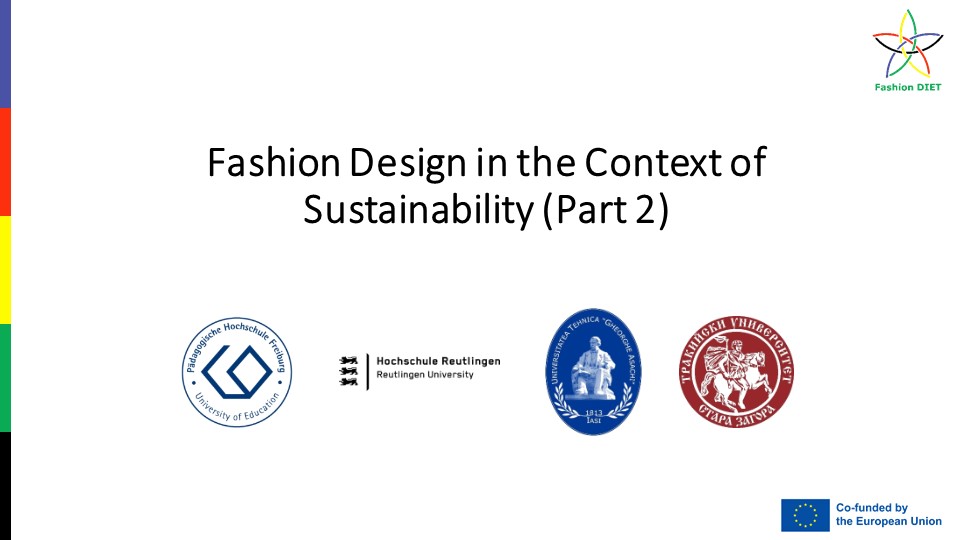
The presented topic is oriented to the slow fashion design based on application of the long-life elements and sustainable proportions of the golden ratio and Fibonacci sequence.
The slow fashion is an aspect of sustainable fashion and is the opposite concept of the fast fashion. The slow fashion offers sustainable fashion solutions, which are based on new strategies for design, manufacturing, consumption, use and re-use that challenge the global fashion system. The slow fashion involves a fashion awareness of the production and resources required to create clothing. The slow fashion promotes the purchase of higher-quality clothes with trendless design that will last longer, and fair treatment of people, animals, and the environment.
The trendless designs are based on application of the long life fashion elements.
A study of women’s fashion of the last decade of 20th Century and 21st Century from the beginning till now shows that there are elements, which stay in fashion for a longer period of time or in other words they are always in trends. The application of long live fashion elements in design is a precondition for the long life of clothes. These elements are: drapes, other 3D elements, peplums, non volume silhouettes.
Drapes take their place in the contemporary fashion in the first half of the 20th Century. Then Mariano Fortuny created his draped, inspired by ancient Greek costume, evening “Delphos” dresses. A little later, the draperies have been developed in the creativity of Madeleine Vionnet and Madame Grès. Madeleine Vionnet has been called the “Queen of the bias cut”. She introduced the bias cut to the fashion design. Madame Grès has been called the “Queen of the drapery” and the “Master of the wrapped and draped dress”.
Other 3D elements, which are the tucks, pleats, gathers, and ruffles, came into the contemporary fashion at the same time.
The peplum comes in contemporary fashion from the ancient Greek overdress “peplos”. Mariano Fortuny has been inspired not only by drapes in ancient Greek costumes, but by peplos too. Peplums have been seen in Christian Dior’s “New Look” designs.
Non volume silhouettes are always in trends.
There are presented designs with:
- All types of drapes: free drapery; drape, formed with a seam or darts; twist knot drape, or drapery, fixed in a knot; and twisted drapery;
- Peplums, combines with 3D elements;
- Combined silhouettes based on non volume and volume silhouettes shaped with the help of drapes, 3D elements and peplums.
In creation of sustainable fashion products, the designers must not compromise on the application of the design principles.
There are many examples of zero waste fashion designs, upcycled designs, circular designs, etc., which are with not so good aesthetic value. The balance have to be found between a sustainable fashion conception and the applying of the design principles, which are symmetrical and asymmetrical balance, proportions, rhythm, emphasis, unity.
There is a principle which is strongly connected with sustainability. It is the proportion. The proportions in combination with symmetrical or asymmetrical balance determine the next principles of rhythm, emphasis, and unity.
The Golden ratio and Fibonacci sequence are applied as proportions in design as expressers of beauty and harmony and it is a result of strong connections in their mathematical nature. The golden ratio has been applied as harmonic proportion in the art and architecture since the ancient times. In more recent times, the relations between Fibonacci numbers have been also beginning to be used as harmonic proportions. Therefore, the proportional relations of the golden ratio and Fibonacci sequence are the best examples of sustainable proportions.
There are presented fashion designs of clothes and accessories and textile designs based on:
- Direct application of the golden ratio and Fibonacci sequence as proportions;
- Applying geometrical figures based on the golden ratio and Fibonacci sequence;
- Applying tiles based on the golden ratio and Fibonacci sequence.
A study on the long life fashion elements shows some reasons for their sustainability in trends: They are with high aesthetic value and are elegant and feminine ones. They can be combined easily each other or with other elements of fashion design.
The applying of the sustainable golden ration and Fibonacci sequence proportions gives beauty, harmony and sustainability in fashion design of clothes and accessories, and textile design. The use of the golden section and Fibonacci series bring aesthetics in designs, based on different sustainable conceptions (zero waste, upcycled, circular designs, etc.) and can be applied as emphasizers of the long life fashion elements.
Zlatina Kazlacheva
Content:
-
Please find below the PDF document of the lecture “Fashion Design in the Context of Sustainability (Part 2)”.
The document contains notes by the author.
-
Please find below the Powerpoint presentation of the lecture “Fashion Design in the Context of Sustainability (Part 2)”.
The presentation contains notes by the author.
-
Here you can download all documents of the lecture in a bundle:
-
Please give us your Feedback on the Lecture “Fashion Design in the Context of Sustainability”.
-
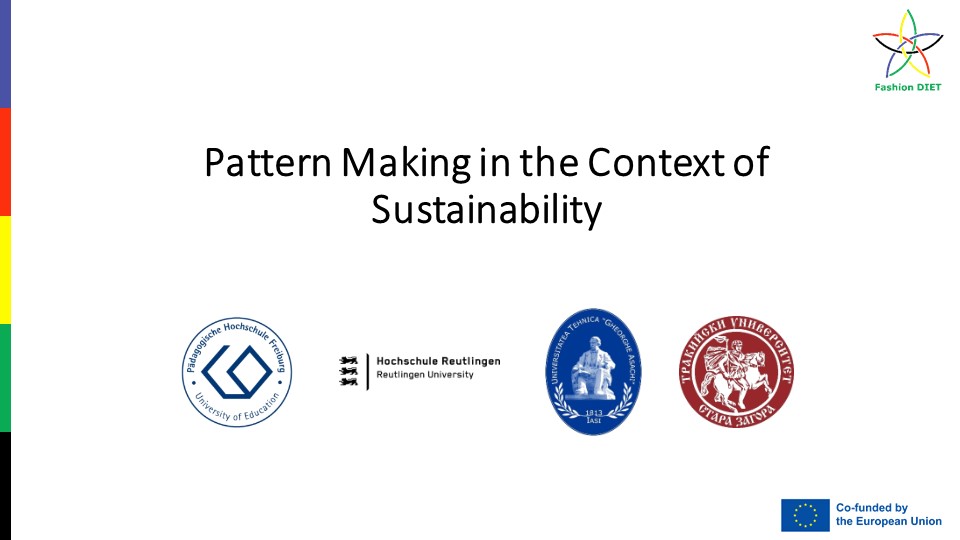
The topic presents accurate and facilitated geometrical approaches of pattern making and pattern design examples of women’s clothes with sustainable long life fashion elements, sustainable proportions, minimizing and zero waste cutting.
The slow fashion trendless designs are result of combinations of high quality design, making of high quality pattern, and high quality of fabrics and other materials.
In other words, the high quality design, based on the long life fashion elements, require high accuracy of the geometrical constructional approaches, used for pattern making of clothes with their application.
Geometrical approaches of accurate and facilitated pattern design of women’s clothes with the fourth types of drapes are presented. The fourth types of drapes are: free drapery; drape, formed with a seam or darts; twist knot drape, or drapery, fixed in a knot; and twisted drapery.
A way of correct constructional sequence of pattern making of women’s clothes with peplums is shown.
Application of the golden ratio and Fibonacci sequence as sustainable proportions is presented. In most cases, they are applied is in pattern making as direct proportioning or through geometrical figures. The figures are used as shapes of elements and pieces, or as a frame of forming of shapes of elements and pieces. Examples of applying of the golden section and Fibonacci series in pattern making through directly use or geometric figures are shown. The geometric figures are the golden triangle, the golden rectangle, the golden ellipse. Some of designs combine the golden ratio and Fibonacci sequence proportioning and long life fashion elements of different types of drapes and other 3D elements.
Some pattern making solutions offer lower consumption of textile material and minimizing waste cutting. With the help of these constructive solutions, minor changes can be made to the design, keeping the main idea of the design. For example, the classic one-piece or two pieces sleeves in women’s jackets can be replaced with drop shoulder ones. This only one change in the design and pattern making of the jacket leads to the lower consumption of textile material and minimizing waste cutting.
Zero waste fashion conception about design and pattern making, which eliminate cutting waste, offers interesting constructional ideas. For example, an idea for easy zero waste cutting of A line skirts, lower parts of dresses, or peplums is presented.
The accuracy of presented approaches of pattern making of women’s clothes with drapes is based on the correct and facilitated geometric sequences of constructing of the fourth types, and the correct and easy formulas, used for the twist knot and twisted draperies. The applying of the formulas lead to correct pattern design for all possible combinations of sizes of the elements of drapes.
The presented pattern designs are examples of sustainable and correct pattern making of women’s clothes with sustainable long life fashion elements of all types of drapes, peplums, and 3D elements; sustainable golden and Fibonacci sequence proportions through direct proportioning or geometric figures; lower consumption of textile material and minimizing waste cutting; zero waste pattern cutting; and combinations between them.
Zlatina Kazlacheva
Content:
-
Please find below the PDF document of the lecture “Pattern Making in the Context of Sustainability”.
The document contains notes by the author.
-
Please find below the Powerpoint presentation of the lecture “Pattern Making in the Context of Sustainability”.
The presentation contains notes by the author.
-
Here you can download all documents of the lecture in a bundle:
-
Please give us your Feedback on the Lecture “Pattern Making in the Context of Sustainability”.
-
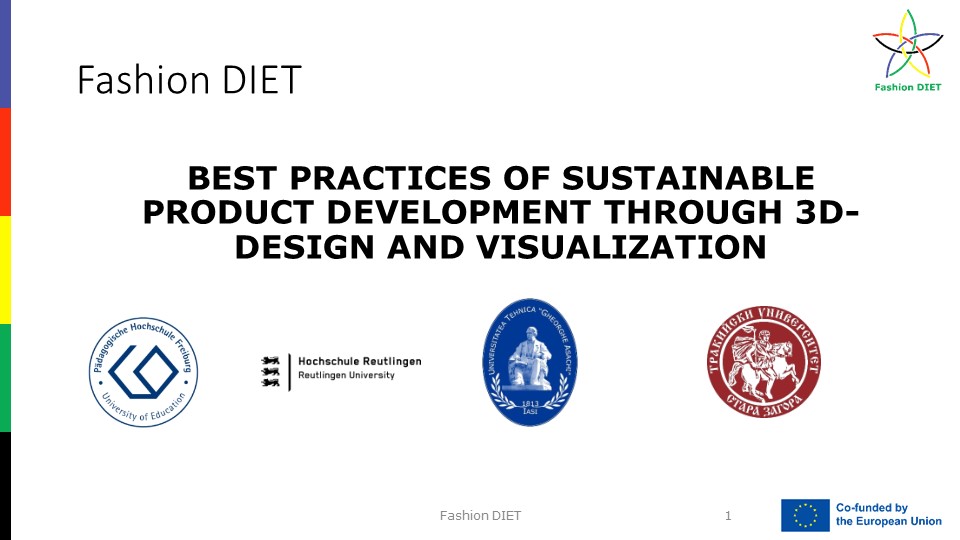
Digital technology is and will be increasingly present in daily life. It will bring significant changes, improvements and also challenges. The European Commission wants to bring about a significant shift towards a digitalised work and business life by 2030. The EU Commission’s goal is to achieve a climate-neutral Europe by 2050, which in turn will protect the planet and the population. Europe’s digital transformation amounts to “a digitally skilled population and highly skilled digital workforce, secure and sustainable digital infrastructures, the digital transformation of businesses and the digitisation of public services” (https://digital-strategy.ec.europa.eu/en/policies/europes-digital-decade). New technologies and globalisation are opening up new avenues for consumption, production, and commerce and are fundamentally changing the customer’s behaviour. As a result, fashion companies need to adapt and revise their business methods to meet new demands, seize the opportunities of digitalisation, and ensure sustainable business success.The company will have a new, completely virtual structure that is able to face and adapt to the new situations: the different needs and requirements of customers, products and services.
The digital approach to product development facilitates collaboration work platforms, virtual meetings, and automated processes (as in finance). This technology provides the opportunity to improve the relationship with the customers. The company receives customer feedback, analyses their ideas and suggestions, and has the opportunity to identify where and how to make changes, if necessary.
A digital business transformation must be based on sustainable principles. This involves collaborative methods for capturing transdisciplinary knowledge: the need to link research and practice; data collection efforts and social considerations; collaborative planning to harness the power of digitisation and artificial intelligence (D&AI), (Gupta, 2020, https://www.mdpi.com/2071-1050/12/21/9283/htm). The latest research in the field of digitalisation and artificial intelligence concludes that “there must be a matrix between them, called Digitainability” (Gupta, 2020, https://www.mdpi.com/2071-1050/12/21/9283/htm).
A digital alternative suitable for the fashion and apparel industry is 3D: virtual 3D prototypes, 3D visualisation, 3D body scanning, and virtual try-ons solve the problem of proper fit while avoiding bottlenecks in the supply chain. In this way, the apparel sector can achieve green goals without polluting the environment with wasteful manufacturing processes.
The prospect of 3D simulation technology is promising for fashion designers and fashion education. A good example of how 3D simulations can be used in the fashion industry is the hyper-realistic presentation of designer collections. The digital evaluation of the fitting degree of a garment product is very accurate in 3D simulations. There are basically two methods of simulating garments models: geometric and physically-based models. Physically-based models are more realistic and easier to implement compared to geometric models.
Using 3D technology to develop new models has the following advantages: design changes made in 2D or 3D are immediately visible in both the pattern and simulation; 3D simulated garments better reflects what products look like in reality; the 2D pattern can be plotted and used to manufacture the garment product; the simulated garment is visible from all angles, allowing the designer to view the model and make adjustments as needed. In this way, errors in fit, prints, proportions, balance, and shaped construction lines can be corrected more quickly; changes are made relatively quickly, and the process is self-correcting; fabric drape can be assessed and adjusted from a fabric library; quick and accurate positioning and scaling of prints, logos, and other details; new ideas can be quickly tried out, and the changes can be immediately visualised; complex garment shapes can be visualised as well; fabrics are available in unlimited quantities.
Designing becomes a digital, iterative process where variations and unexpected outcomes inspire and stimulate the designer’s creativity and imagination. It also becomes self-directed. Interaction with CAD helps the designer see the “rest” of the model and learn about the design in the final phase of the 3D stage.
In summary, this module provides general insight into product development using 3D methods (design and visualisation) that will help designers create exceptional items and improve efficiency in evaluating the creation of conceptual models to better support interactive design activities for apparel displays.
Manuela AVADANEIContent
-
Please find below the PDF document of the lecture “Best practices of sustainable product development through 3D-design and visualization”.
The document contains notes by the author.
-
Please find below the Powerpoint presentation of the lecture “Best practices of sustainable product development through 3D-design and visualization”.
The presentation contains notes by the author.
-
Here you can download all documents of the lecture in a bundle:
-
Please give us your Feedback on the Lecture “Best Practices of Sustainable Product Development through 3D-Design and Visualization”.
-
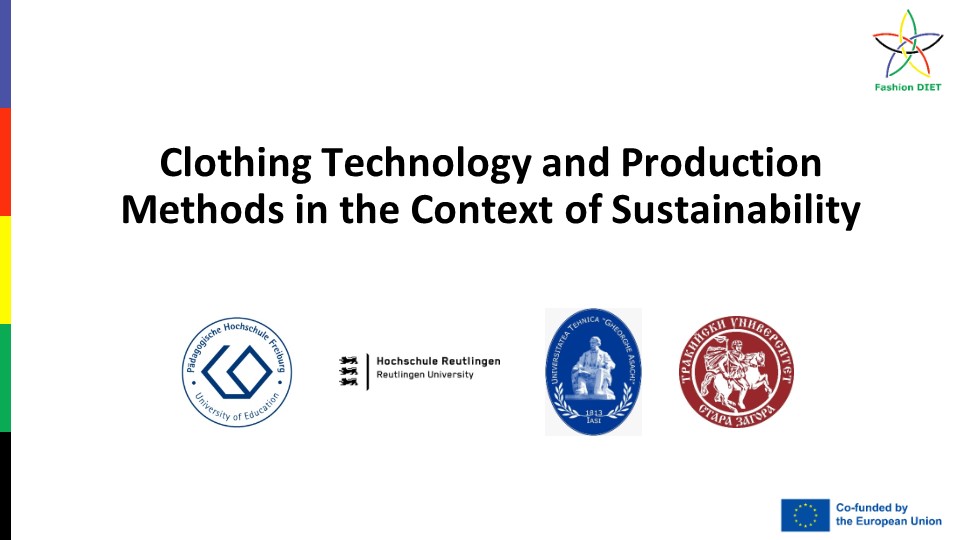
The apparel industry accounts to 10% of global carbon emissions. More sustainable apparel production can therefore significantly contribute to more sustainable economies. When it comes to improving sustainability in the apparel sector, data science and recycling technologies have the strongest potentials.
Many technologies are already available to make the garment supply chain more sustainable. However, most promising technologies require extensive effort, money and collaboration to produce actual tangible results.
European apparel companies are looking for materials, fibres and techniques that are sustainable and functional. These materials can be natural or synthetic, as well as renewable or recycled.
A sustainable manufacturing system is that the manufacturing system, usually oriented product, which has been designed by introducing environmental factors (eco-design), taking into account not only the stage of manufacturing the product, but also for all stages of the cycle of life, from the procurement of resources, until the final treatment and recycling once their useful life. The objective that seeks a sustainable product system is mainly an environment sustainability, balance in manufacturing systems to maintain and even improve the quality of life of present generations without causing irreparable damage to the ecosystem, can be used future generations, this is the base of industrial ecology. The origin of this evolution towards the search for a sustainable product system determined by social sustainability, the protection of workers and the maintenance of the environment, using instruments such as legislation, decisions adopted by consensus of almost all world governments. The integration of sustainable manufacturing must be do at a global level, at all hierarchical levels of the company where the application of sustainability factors for efficiency of the production process, achieving economic sustainability.
This lecture presents the distinctive features of sports-functional apparel manufacturing and the development of assembly technologies such as sewing, welding and gluing, along with the upcoming challenges in this field. New technologies for the production of sports-functional clothing fabrics presents.
Combining of natural and synthetic materials in apparel products caused problems with material recovery, reuse, recycling, or composting at the end of product life. The concept of disassembly design and its application to the designing and making of men's jacket presented. With this type of design, consumers and manufacturers can easily compost, recycle, or reuse different materials and components at the end of the garment’s usable life.
The presented clothing technologies for sustainable sportswear production offer examples to search for new ideas for sustainable clothing technologies and realize new fashion designs with minimal environmental footprint.
Diana BalabanovaContent:
-
Please find below the PDF document of the lecture “Clothing Technology and Production Methods in the Context of Sustainability”.
The presentation contains notes by the author.
-
Please find below the Powerpoint presentation of the lecture “Clothing Technology and Production Methods in the Context of Sustainability”.
The presentation contains notes by the author.
-
Here you can download all documents of the lecture in a bundle:
-
Please give us your Feedback on the Lecture “Clothing Technology and Production Methods in the Context of Sustainability”.
-
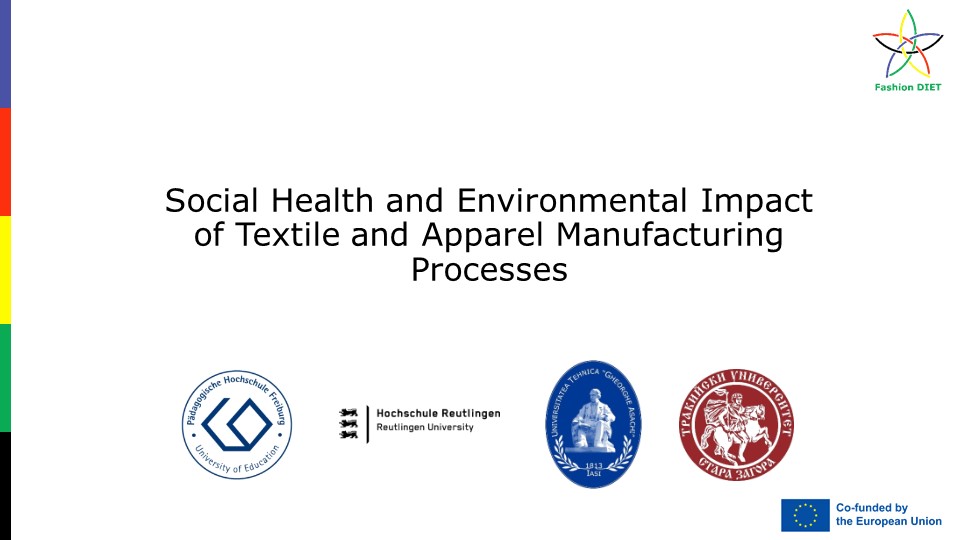
The textile and apparel industry in developing countries contributes a lot to the growth of the economy and plays an important role in providing the employment to the rural and urban population. Beside this positive economic impact, it still poses textile workers in many textile and apparel manufacturing processes to occupational health risks. Although the organisation of the production process has changed in recent years, the safety and health hazards in the industry remain the same due to the lack of respective standards. The hazards in the textile and clothing industry are widespread and include mechanical, physical, chemical, ergonomic and physiological hazards, such as exposure to cotton dust, exposure to chemicals, noise and ergonomics issues etc. There are also some factors which are responsible to create further hazards in the working environment, i.e. job strain, improper use of personal protective equipment, stress, unhealthy working environment with low lighting and high humidity and poor working conditions. Furthermore, today fast fashion deadlines create a climate of harassment and violence in Asian factories. The various workplace hazards, risks and resulting diseases as well as harassment especially against female garment workers will be discussed elaborately in this lecture.
The textile industry for instance consumes numerous chemicals in the manufacturing and processing of textiles associated with operations such as desizing, mercerization, scouring, bleaching, dyeing, finishing and laundering. Particularly in the wet processing of textiles, chemicals make up about 70% of pollution in the industry. There are numerous health and safety issues and chemical accidents arising each year from the exposure of textile workers to hazardous chemicals and enzymes that are associated with processes such as fibre synthesis, weaving and wet processing. How these chemicals influence the overall environment as well as the human ecology during textile processing methods will be disclosed in this course.
In recent years, a clearer understanding of the chemical hazards paved the way for regulations by governments of countries across the globe and the introduction of eco-labels, both by the government and the industry. However, governmental regulations concerning workplace safety are still lagging, even after the Rana Plaza building disaster in 2013. Despite real improvements there are still many shortcomings in terms of labour relations and control. As education is a fundamental human right, that is settled in the UN’s Sustainable Development Goal No. 4 and helps the growth of a nation, it is essential that textile workers are aware of the various occupational hazards. However, employees in third world countries still suffer from a lack of education regarding occupational safety. Instead, textile workers are uneducated, often illiterate and most of them do not know what protective measures should be adopted for their jobs. Therefore it is necessary that the management takes the necessary steps to protect workers from potential hazardous situations and to foster education and health as a key component of human development. At least, informal education would help textile workers to gain knowledge about their medical rights, legal and social behaviour.
Despite that, consumers in high income countries play a major role in supporting companies and practices that minimise their negative impact on textile workers’ health and the environment. Efforts to make clothing more sustainable require acceptance by consumers with possibilities for several courses of action like raising consumer awareness, increasing transparency and eco-labelling as well as implementing precise textile care and recycling instructions to extend the longevity of clothes. In conclusion, though chemicals and textiles are inseparable, sustainable approaches should be encouraged and implemented throughout the textile and fashion sector.
Dirk HöferContent:
-
Please find below the PDF document of the lecture “Social Health and Environmental Impact of Textile and Apparel Manufacturing Processes”.
The document contains notes by the author. -
Please find below the Powerpoint presentation of the lecture “Social Health and Environmental Impact of Textile and Apparel Manufacturing Processes”.
The presentation contains notes by the author.
-
Here you can download all documents of the lecture in a bundle:
-
Please give us your Feedback on the Lecture “Social, Health and Environmental Impact in Textile and Apparel Manufacturing Processes”.
-
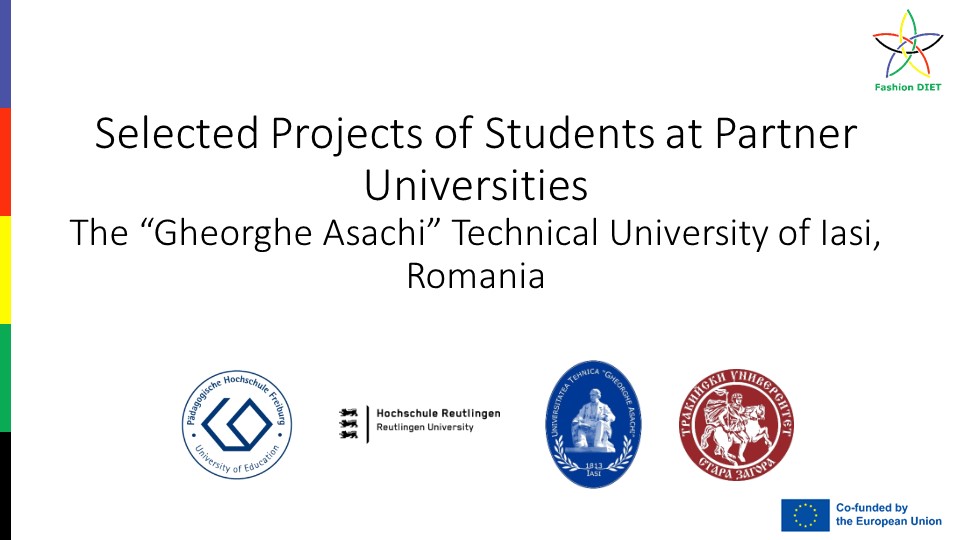
The module briefly presents the studies developed by students from the Master's studies specializing in modelling and clothing design, within the discipline of Sustainability in fashion. Each of the 3 studies is a unique approach to some current and pressing aspects regarding the sustainable development in fashion.
Study 1
Through the lens of the author, TEODORESCU Camelia-Andreea, sustainability is a way of living and includes consumer education itself, promotion of personal style regardless of trends, awareness of environmental issues, appreciation and support of sustainable fashion producers, and above all identity and status for the good of the self. The consumer is the key factor when it comes to sustainability. From a psychological point of view, the consumer is subject to social stress when it comes to clothing. Promoting trends has become a social norm, and not belonging to these trends, which otherwise change much too quickly, made the consumer dependent on fashion, but not on defining his own, different style. These rapid trends lowered the self-esteem of the consumer and made him feel that he did not fit into society if he did not wear the appropriate fashion trends. In this context, the student's collection was developed around the concept of personalizing worn/used clothing through handmade painting. Personalizing clothing gives a sense of uniqueness, makes the wearer feel special, reinforces the sense of identity and creates a more personal experience.
Study 2
The project carried out by POHOATA Roxana proposes the practical as well as aesthetic exploitation of the concept of textile waste recycling. In the idea of supporting the "recycle, upcycle & sustainable" triad, although paradoxical as a term in the context of sustainable fashion, the student brings in the use of a technique that allows continuous reuse in a productive vision. Upcycling includes performing value-added activity on disassembled material or clothing in such a way as to create a product of greater quality or value than the original. Under the name "Revive Project", the collection aims to reuse or convert fabrics into new fashion products, a theme that is part of the creative practice of any designer. The manipulation of different fabrics with various contrasting textures are proposed with the idea of generating wearable and sustainable fashion. The reintegration of textile waste into an experimental-creative collection is proposed, representing a challenge in finding both technical and aesthetic solutions. The student intensively explores the contrast resulting from the mixing of fabrics such as knitwear, organza, tulle, and the ultra-feminine aspect of cuts and volume.
Study 3
JOANDRA Maria-Mirabela's study highlights the fact that sustainable fashion is a design philosophy and a movement that promotes the environment and social responsibility. We can also talk about sustainability in terms of the old manual techniques for obtaining textile products. Today, manual activities know a global re-appreciation, being generically defined as HANDMADE. Craft means both trade, profession, and skill, ability, talent. Crafts, regardless of their nature, combine the practical spirit with the need for beauty and the aesthetic sense manifested by man in his development. The "philosophy" that hides behind authentic craft products refers to perennial values such as kindness, love of neighbour, patience, faith or communion between everyone and everything. The basic idea was to create a clothing collection that recycle lace. The technique used for this collection is to attach lace elements to the tulle and bind them by felting with non-spun, coloured wool. The collection includes 8 stylized models, in which lace elements are superimposed with felted surfaces. All designs are decorated with shapes made by felting directly on the lace and embellished with wooden beads to keep the vintage style.
As conclusions resulting from the works presented, it can be said that fashion is no longer about buying what's on trend and ending up with piles of clothes that will struggle to see the light of day after being worn just once or not at all. These clothes that we buy on impulse only end up adding to the existing and ever-growing waste in landfills and seriously harming the ecosystem. We have to take a conscious step in the future to stop encouraging the concept of Fast Fashion that has had a strong impact on the ecosystem and life in general, and move closer to fashion that is more sustainable, a trend that is healthier for the planet and future generations.
Coordinator: Prof. Dr. Antonela Curteza
Content:
-
Please find below the PDF document of the lecture “Selected Projects of Students at Partner Universities (Part 1)”.
The document contains notes by the author.
-
Please find below the Powerpoint presentation of the lecture “Selected Projects of Students at Partner Universities (Part 1)”.
The presentation contains notes by the author.
-
Here you can download all documents of the lecture in a bundle:
-
Please give us your Feedback on the Lecture “Selected Projects of Students at Partner Universities (Part 1)”.
-

Previous topics about fashion design and pattern making in the context of sustainability introduce materials about the long-life fashion elements, the pattern making of slow fashion clothes, the sustainable proportions, and zero or minimizing waste pattern design:
The long-life fashion elements stay in fashion for a longer period or in other words they are always in trends. The application of these elements in design is a precondition for the long life of clothes (slow fashion). These elements are:
- Drapes. The draperies are always in fashion trends. The free and twist knot ones are the more popular types of drapes.
- Other 3D elements. The tucks, pleats, gathers, and ruffles are with long life in fashion.
- Peplums. Although they are not as popular as 10 years ago, they are still in trends for a long time.
-
Non volume silhouettes. They
are always in trends.
The slow fashion design required high level of quality of pattern making, which provides accurate geometrical construction and correct dimensioning.
The sustainable fashion design is supported by sustainable proportion, as the more sustainable ones are based on the golden ratio and Fibonacci numbers. The golden section and Fibonacci sequence can be applied in proportioning in clothing directly, or by applying geometrical figures and tiles in their proportions.
The zero or minimizing waste conception has to be applied without compromises with the quality of fashion design and pattern making.
For more successful sustainable fashion design, the application of the long-life fashion elements, the correct pattern making, the sustainable proportions, and the possibilities for zero or minimizing waste can be combined.
This lecture presents selected results of PhD and MSc Theses in the fields of fashion design and pattern making of PhD and Master’s degree students at the Faculty of Technologies of Yambol, Trakia University of Stara Zagora, Bulgaria:
- Improvement of constructional approaches
of pattern design of women’s clothes with symmetric and asymmetric draped
necklines with dependences of dimensioning the neck openings.
- Adaptation of the equation of sizing symmetric neckline for golden proportion between the width and depth if the neck opening.
- Adaptation of a geometrical approach of pattern making of women’s clothes with twist knot drape for knitted fabrics.
- Development of a constructional approach of pattern design of women’s twist clothes.
- Design and pattern making of women’s dresses with peplums, which are combined with different types of 3D elements.
- Minimizing waste designs of women’s dresses with application of the golden ratio and Fibonacci series tiles.
The presented students’ projects on sustainable design and pattern making of women’s clothes can be seen as examples for development of new ideas and creation of new slow fashion designs with different types of long-life elements, golden and Fibonacci proportions, minimizing waste, and combinations between them.
Zlatina Kazlacheva
Content:
-
Please find below the PDF document of the lecture “Selected Student Projects at Partner Universities (Part2)”.
The document contains notes by the author.
-
Please find below the Powerpoint presentation of the lecture “Selected Student Projects at Partner Universities (Part2)”.
The presentation contains notes by the author.
-
Here you can download all documents of the lecture in a bundle:
-
Please give us your Feedback on the Lecture “Selected Student Projects at Partner Universities (Part 2)”.
-

The fashion and clothing industry is one of the most innovative sectors in Europe. These industries form interconnected value chains from the design and manufacture of textiles (along with textiles, clothing, footwear, leather products, fur products, jewellery and accessories) to their distribution and retailing. Despite this fact, this industry has to deal with political conflicts, financial and economic crises, climate change, dwindling natural resources, population migration, development of production technology (automation, robotisation), dynamics of jobs, consumer behaviour and profiles, etc. Production is prone to disruption from all-natural disasters. Outsourcing production means that relationships and communication are key to mitigating risks related to quality control, delivery reliability, etc. Short seasons for fashion items mean that the logistics of supply are critical to the success or failure of businesses. Many fashion retailers operate with very low inventories and use responsive manufacturing techniques that improve overall efficiency but also put additional strain on the supply chain. The international flow of fashion goods and the resulting “virtual company networks” are in many respects similar to high-tech supply chains in their complexity. So, where there are still manufacturers in Europe, they tend to outsource the labour-intensive parts of the manufacturing process to low-wage countries. This differs slightly from retailers who buy goods directly from cheaper long-distance suppliers, as subcontractors are integrated into the manufacturer’s internal supply chain. The fashion and apparel industry constantly has to reinvent its business models in the face of currency pressures resulting from trade liberalisation, increased external competition, technological advances, adjustments in manufacturing costs and environmental concerns.
Under these conditions, the European Commission has launched a new programme aimed at implementing sustainability principles in the textile and clothing industry. This action can have a huge impact on fashion companies and aims to create a greener, more competitive sector by transforming the way textiles are produced and consumed. It will introduce new layout requirements, greenwashing regulations, regulations to prevent overproduction and overconsumption, and numerous new projects that will impact the business as a fashion employer.
The idea of sustainability has become a powerful word that brings some changes. Consumers are now taking a closer look at the foods they consume and the chemicals they put in their bodies. They are also changing their purchasing decisions by choosing the items that can define a cleaner environment. Some fashion brands are aware of their unsustainable practices, but it is not easy for them to change. Nonetheless, consumer demand for ethical products is already forcing the fashion industry to adapt, as evidenced by the increasing number of campaigns promoting sustainable practices in the fashion industry.
In summary, this module provides a general description of the specific challenges of the fashion and apparel industry. It offers insights on transforming it into a sustainable one, where the items are manufactured with minimal environmental impact.
Manuela AVADANEI and Mirela BLAGA
Content:
-
Please find below the PDF document of the lecture “Chances and Risks of a Sustainable Textile and Clothing Production in the European Market”.
The document contains notes by the author.
-
Please find below the Powerpoint presentation of the lecture “Chances and Risks of a Sustainable Textile and Clothing Production in the European Market”.
The presentation contains notes by the author.
-
Here you can download all documents of the lecture in a bundle:
-
Please give us your Feedback on the Lecture “Chances and Risks of a Sustainable Textile and Clothing Production in the European Market”.
-

The textile industry in Europe includes a wide range of products and processes such as spinning, knitting, weaving and finishing of textiles, followed by the production of industrial and technical textiles. All stakeholders in textile education are working to develop programmes that reflect the modernity of these industries and the wide variety of career opportunities they offer today. The workforce is the greatest asset of the textile and apparel industry, which must preserve existing know-how, and this is only possible if it employs qualified people.
Therefore, the lectures in the second part of the module ESD entitled "Sustainable Textile Technologies and Fashion in the European Market" aim to create awareness of the key issues of each topic related to the development of sustainable products. They are designed to improve teachers' professional skills and their content can be part of curricula at different educational levels or a valuable source of documentation for teachers.
This first topic focuses on information about classes of textile raw materials, as well as information about the global fibre market and statistics about megatrends. The unit provides a detailed description of natural and man-made fibres, their production, and existing categories, as well as a comprehensive presentation of existing sustainable fibre initiatives, projects, and programmes for those interested. The second lecture in this module introduces the categories of knitting and the methods used to produce knitted fabrics. The sustainable aspects of knitting technology take a central place in the module and concrete solutions are highlighted. Digitalization, which is an ongoing process in the knitting industry and contributes to its sustainable future, is also discussed.
The third lecture addresses key sustainability issues in textile dyeing and printing, particularly the sustainability aspects of textile dye use. Readers will gain knowledge of revolutionary new printing technologies that are environmentally friendly. This continues in the fourth unit, which addresses key issues related to sustainability in textile finishing, such as: high wastewater and water consumption, low-maintenance finishing, potential environmental risks associated with halogenated flame retardants. The presentation will provide information on the possibilities of optimizing existing technologies and replacing environmentally harmful products, as well as the revolutionary eco-friendly finishing technologies.
Lectures five and six focus on the need for sustainable approaches in the fashion and textile industries and on sustainable fashion concepts. The role of design and fashion designers in sustainable development and useful tools for designing for sustainability are explained. Success stories and practices that can serve as inspiration for young designers are presented.
The seventh lecture explains how to make correct patterns for women's clothing with sustainable, long-lasting fashion elements of all types of draping using facilitated construction procedures and simple calculations, and how to make accurate patterns for women's clothing with the long-lasting fashion element of peplum. The eight unit trains students to characterize product development for the mass customization fashion industry and presents sustainable solutions for product development in fashion and apparel industry. The topic also informs trainees on how to characterize digital apparel development and describe best practices of sustainable product development for fashion and apparel industry.
The ninth subject provides knowledge about the characterization of functional sportswear and the description of new technologies for functional sportswear. The subject trains students to characterize functional sportswear and describe new technologies in functional sportswear. The unit also teaches the assembly technologies for functional sportswear and understanding the design and garment technology for disassembly.
Topic number ten addresses information on the environmental impact of textile and apparel manufacturing processes on the health of society, as well as the physical, chemical, environmental, and occupational hazards in textile manufacturing processes.
In the eleventh unit, projects developed by students of the master's program are presented. They are inspired by the concept of personalizing worn/used clothing through handmade painting, or integrating textile waste into an experimental creative collection, or stylizing models in which lace elements are overlaid with felted surfaces. In the twelfth lecture, students are trained to design garments with sustainable, long-lasting fashion elements: draping, other 3D elements, and peplums, as well as garments with sustainable proportions based on the golden section and Fibonacci sequence.
Lecture thirteen discusses the challenges in the European textile and clothing market and the threats in the European textile and clothing market. The topic offers information on sustainability in textile and apparel production, which is hardly conceivable without the transformation from a predominantly linear economy to a consistent circular economy, the simultaneous reduction of overconsumption and the rapid reduction of CO2 emissions.
Finally, the second part of the module ESD addresses its technical content to lecturers, teachers and trainers in higher education or vocational training, as well as to their students as future professionals in the textile and fashion industry. The outlook discusses the status and needs of the textile industry. It also presents teaching and learning approaches that can be adapted to the technical content to implement the principles of ESD.
Mirela Blaga and Zlatina Kazlacheva
Content:
-
Please find below the PDF document of the lecture “Summary, Reflections and Outlook - Part 2”.
The document contains notes by the author.
-
Please find below the Powerpoint presentation of the lecture “Summary, Reflections and Outlook - Part 2”.
The presentation contains notes by the author.
-
Here you can download all documents of the lecture in a bundle:
-
Please give us your Feedback on the Lecture “Summary, Reflections and Outlook - Part 2”.
-